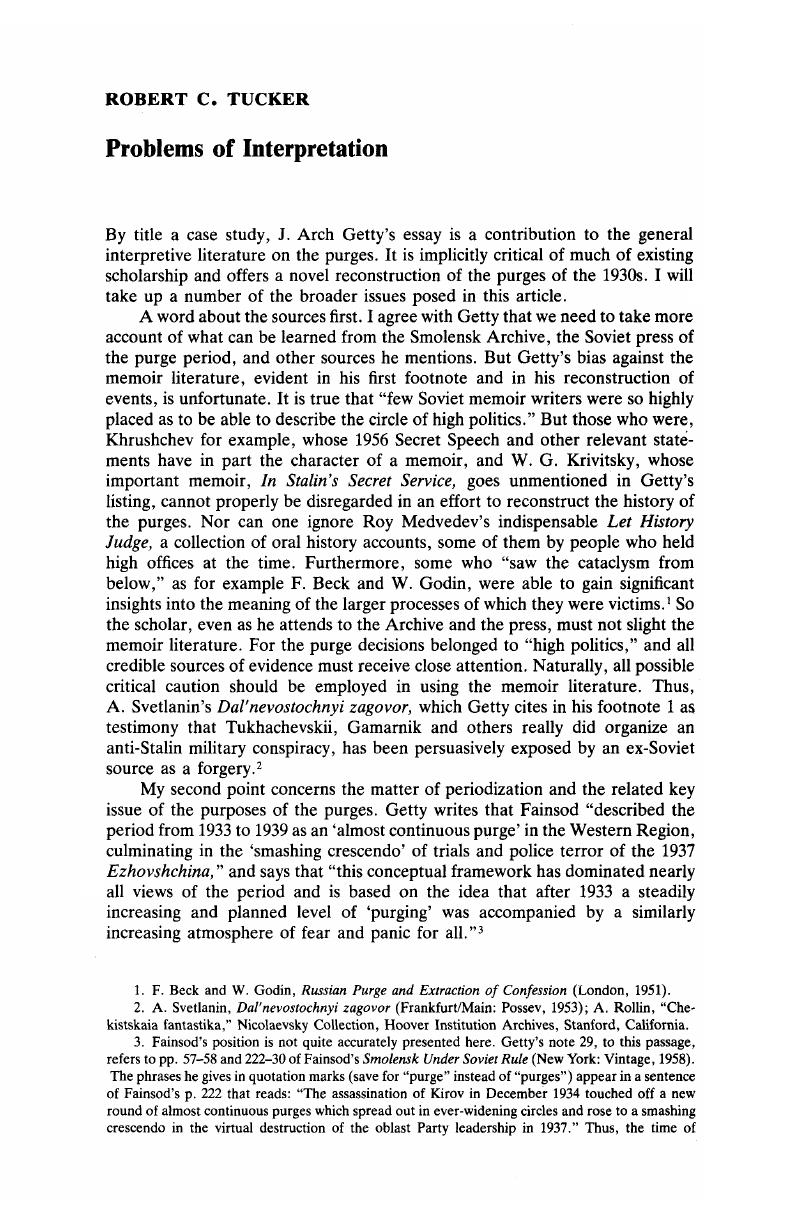Article contents
Problems of Interpretation
Published online by Cambridge University Press: 27 January 2017
Abstract

- Type
- Discussion
- Information
- Copyright
- Copyright © Association for Slavic, East European, and Eurasian Studies. 1983
References
1. F. Beck and W. Godin, Russian Purge and Extraction of Confession (London, 1951).
2. A., Svetlanin, Dal'nevostochnyi zagovor (Frankfurt/Main: Possev, 1953)Google Scholar; A. Rollin, “Chekistskaia fantastika,” Nicolaevsky Collection, Hoover Institution Archives, Stanford, California.
3. Fainsod's position is not quite accurately presented here. Getty's note 29, to this passage, refers to pp. 57-58 and 222-30 of Fainsod, 's Smolensk Under Soviet Rule (New York: Vintage, 1958 Google Scholar). The phrases he gives in quotation marks (save for “purge” instead of “purges“) appear in a sentence of Fainsod's p. 222 that reads: “The assassination of Kirov in December 1934 touched off a new round of almost continuous purges which spread out in ever-widening circles and rose to a smashing crescendo in the virtual destruction of the oblast Party leadership in 1937.” Thus, the time of ever-intensifying terror is dated by Fainsod not from 1933, as Getty suggests, but from December 1, 1934, when Kirov was murdered.
4. Merle, Fainsod, How Russia Is Ruled, rev. ed. (Cambridge, Mass.: Harvard University Press, 1963), pp. 439–42Google Scholar. For T. H. Rigby's extremely illuminating division of the terror period into phases, see his Communist Party Membership in the U.S.S.R. 1917-1967 (Princeton: Princeton University Press, 1968), especially pp. 212-14. In Stalin: The Man and His Era (New York: Viking, 1973), p. 388, Adam B. Ulam describes 1934-36 as “the preliminary phase of the Great Terror.” In my own work in preparation, Stalin and Soviet Russia: Revolution From Above 1929-1939, the period from Kirov's murder to August 1936 is called the “quiet terror” to distinguish it from the unbridled terror that began about the time of the first great show trial in August 1936.
5. Fainsod, Smolensk, p. 222. “The Kirov meetings,” adds Fainsod, “provided the occasion for a mass outburst of denunciations and the accumulation of long lists of suspects many of whom were soon destined to be expelled from the Party.“
6. However, even if one does not view the Kirov murder as Stalin's doing, that event still figured as the turning point toward the terror. Thus Ulam, who does not consider Stalin responsible for the murder, nevertheless sees it (see n. 4 above) as inaugurating the “preliminary phase of the Great Terror.“
7. Smolensk Archive, WKP 499, cited by Fainsod, who notes in this connection (Smolensk, p. 223) that protocols of party meetings in the Western Region, held in response to a Central Committee resolution of June 27, 1935, which rebuked the region's party leaders for their inadequate response to the May letter's orders, “register a mood of mounting hysteria.“
8. Rigby, Communist Party Membership, p. 297. Rigby here cites a progress review of August 1935 published in Partiinoe stroitel'stvo, which castigated party officials “who had underestimated the political importance of the ‘verification,'” and he notes (p. 209) that total party membership fell by about 300,000 in 1935 and 200,000 in 1936.
9. “Letter of an Old Bolshevik,” in Nicolaevsky, Boris I., Power and the Soviet Elite (New York: Praeger, 1965), p. 56 Google Scholar.
10. It is inaccurate to say, as Getty does, that “1935 was a relatively calm year for the former opposition.” His footnote to the sentence containing this statement reads: “The ‘Letter of an Old Bolshevik,’ for example, notes that the sudden trial of Zinov'ev and Kamenev in 1936 was a bolt from the blue which came after a period of ‘calm and confidence’ for the opposition.” However, the “calm and confidence” of which the “Letter” speaks (on p. 26, cited by Getty) is that of the “political elite” or “officer corps of the Communist Party” and not that of the former opposition.
11. This has led M. Agursky (“The Birth of Byelorussia,” Times Literary Supplement, June 30, 1972, p. 743Google Scholar) to suggest that the Great Purge was in significant part a “national transformation“ whereby various national minority elements that gained strength during and after the Russian Revolution were repressed in favor of the Great Russian element. For a critical examination of Augursky's thesis, see Medvedev, Roy A., On Stalin and Stalinism (Oxford: Oxford University Press, 1979), pp. 112–14Google Scholar.
12. Robert Conquest, The Great Terror: Stalin's Purge of the Thirties, rev. ed. (New York: Collier Books, 1973), p. 127.
- 2
- Cited by




